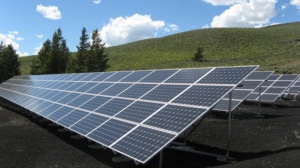In recent years, renewable energy has become a more and more popular topic. More and more people are looking for ways to reduce their carbon footprint, and renewable energy is a great way to do that. There are many different types of renewable energy. Still, in this blog post, we will focus on the four most common types: solar, wind, hydroelectricity, and biomass. We will discuss the pros and cons of each renewable energy so that you can decide which one is right for you.
Wind Energy
 Wind energy is the conversion of wind power into valuable forms of energy, such as electricity or mechanical power. Wind turbines are used to capture the kinetic energy in the wind and convert it into electrical power. The advantage of wind energy is that it is a renewable resource, meaning that we can use it repeatedly. The disadvantage is that it can be unreliable, depending on the weather. Wind energy is an excellent option for people who live in areas with lots of wind. It is also a good option for people who want to reduce their carbon footprint but don’t have access to other types of renewable energy.
Wind energy is the conversion of wind power into valuable forms of energy, such as electricity or mechanical power. Wind turbines are used to capture the kinetic energy in the wind and convert it into electrical power. The advantage of wind energy is that it is a renewable resource, meaning that we can use it repeatedly. The disadvantage is that it can be unreliable, depending on the weather. Wind energy is an excellent option for people who live in areas with lots of wind. It is also a good option for people who want to reduce their carbon footprint but don’t have access to other types of renewable energy.
Natural Gas
Another option for renewable energy is natural gas. Natural gas is a fossil fuel, but it is considered a “clean” fossil fuel because it emits less carbon dioxide than coal or oil. The advantage of natural gas is that it is reliable and relatively cheap. The disadvantage is that it is not a renewable resource, eventually running out. If you choose to use natural gas, ensure that your house is equipped with a carbon monoxide detector.
Solar Energy
 Solar energy is the conversion of sunlight into usable energy. The sun’s rays can be used to generate electricity, heat water for cooking or bathing, and even power appliances in your home. Solar panels are usually placed on top of buildings where they receive direct sunlight throughout most of the day. There are several advantages to using solar energy: renewable, clean, and accessible. The disadvantage of solar energy is that it can be expensive to install panels. They may not work well in cold weather. Solar energy is an excellent option for people who want to reduce their carbon footprint and access direct sunlight throughout the years.
Solar energy is the conversion of sunlight into usable energy. The sun’s rays can be used to generate electricity, heat water for cooking or bathing, and even power appliances in your home. Solar panels are usually placed on top of buildings where they receive direct sunlight throughout most of the day. There are several advantages to using solar energy: renewable, clean, and accessible. The disadvantage of solar energy is that it can be expensive to install panels. They may not work well in cold weather. Solar energy is an excellent option for people who want to reduce their carbon footprint and access direct sunlight throughout the years.
Hydroelectricity
 Hydroelectricity is the conversion of flowing water into electricity. It works by using moving water to turn a turbine, which generates electrical power. This type of energy has several advantages: renewable, clean, and relatively cheap to develop. The disadvantage is that dams are required for hydroelectricity generation, which can negatively impact the environment.
Hydroelectricity is the conversion of flowing water into electricity. It works by using moving water to turn a turbine, which generates electrical power. This type of energy has several advantages: renewable, clean, and relatively cheap to develop. The disadvantage is that dams are required for hydroelectricity generation, which can negatively impact the environment.
In summary, renewable energy is an excellent option for people who want to reduce their carbon footprint and access direct sunlight throughout the years. There are many different types of renewable energy. Still, wind energy, solar power, and hydroelectricity are some of the most popular options.
